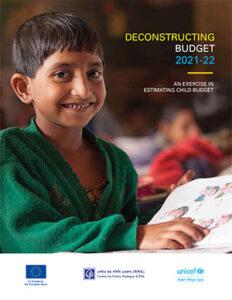Child Welfare Scenario
 About two-fifths of the total population in Bangladesh are children (aged between 0-18 years), which is indicative of the importance of investing in children for the future of the country. It is from this vantage point that, prioritisation of issues of concern to children in policies, allocations for children in public expenditure and allocative efficiency to advance the interests of children, have assumed such heightened interest in the present context of Bangladesh’s development. Since taking good care of children has been enshrined in Bangladesh’s constitution, it is a ‘rights issue’ as far as the children of the country are concerned. However, it is through public policies and public expenditure that these rights will need to be realised on the ground. It is against this backdrop that analysis of budgetary expenditure from the perspectives of children has high practical significance. Such an analysis allows estimating the amount of allocations for specific child-focused programmes and expenditures under various ministries and heads, what proportion of budgetary allocations are going for children, what are the particular projects, and whether these cater to the emerging demands of children.
About two-fifths of the total population in Bangladesh are children (aged between 0-18 years), which is indicative of the importance of investing in children for the future of the country. It is from this vantage point that, prioritisation of issues of concern to children in policies, allocations for children in public expenditure and allocative efficiency to advance the interests of children, have assumed such heightened interest in the present context of Bangladesh’s development. Since taking good care of children has been enshrined in Bangladesh’s constitution, it is a ‘rights issue’ as far as the children of the country are concerned. However, it is through public policies and public expenditure that these rights will need to be realised on the ground. It is against this backdrop that analysis of budgetary expenditure from the perspectives of children has high practical significance. Such an analysis allows estimating the amount of allocations for specific child-focused programmes and expenditures under various ministries and heads, what proportion of budgetary allocations are going for children, what are the particular projects, and whether these cater to the emerging demands of children.
Various studies and surveys testify that Bangladesh has made impressive progress in terms of many child-centric indicators. According to the UNICEF’S MICS, between 2013 and 2019, there were notable progress as regards a number of child welfare indicators, including significant reductions in stunting rate (from 42.0 per cent to 28.0 per cent) under-five mortality rate (from 58 to 40 per thousand live births), and underweight prevalence (from 31.9 per cent to 22.6 per cent). However, the prevalence of wasted (from 9.6 per cent to 9.8 per cent) and overweight children (from 1.6 per cent to 2.4 per cent) has increased between 2013 and 2019. While nationally representative data for the subsequent period for many relevant indicators is not available as yet, it is assumed that child welfare-centric progress was stalled and even reversed in case of several indicators because of the Covid-induced shocks.
Authors: Mustafizur Rahman and Md. Asiful Islam
Publication Period: May 2023

